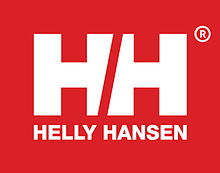Helly Hansen
 |
|
| Private | |
| Industry |
Clothing Survival and rescue gear Fishing equipment |
| Founded | 1877 |
| Founder | Helly Juell Hansen |
| Headquarters | Oslo, Norway |
|
Area served
|
Worldwide |
|
Key people
|
Paul Stoneham (CEO) |
| Products | Industrial workwear Outerwear Street wear Survival and rescue gear Fishing equipment Rafts Lifeboats Rubber products Tarpaulins |
| Revenue | NOK 1400 million (US $228 million) (2005) |
| Owner | Ontario Teachers' Pension Plan (75%) and Altor Equity Partners (25%) |
|
Number of employees
|
~600 |
| Website | www |
Helly Hansen is a producer of textiles and gear for sports and work on the ocean and in the mountains, headquartered in Oslo, Norway. Previously, from the time it was founded in 1877 until October 2009, the company was headquartered in Moss, Norway.
Today, the brand is recognized for its outdoor sports gear as well as the foul-weather fishing gear that can be seen both on television (Deadliest Catch) and in movies (The Perfect Storm, Touching the Void, Everest), but is used in all levels of industrial workwear, survival and rescue, and performance outerwear. On the consumer side, Helly Hansen sells to the sailing and snowsports communities, as well as producing apparel and footwear for casual and active use.
Helly Juell Hansen had been at sea since the age of 14 and in 1877, at the age of 35, he and his wife Maren Margarethe began producing oilskin jackets, trousers, sou'westers and tarpaulins, made from coarse linen soaked in linseed oil. Over the first five years they sold around 10,000 pieces.
In 1878 the company won a diploma for excellence at the Paris Expo, and began exporting its products.
After Helly Juell Hansen's death in 1914, company leadership passed on to his son Helly Hansen, an experienced merchant.
In the 1920s a new fabric, which Helly Hansen called Linox, was developed. The surface was glossy and attractive – and, best of all, non-sticky. Over the next 30 years the name Linox would transfer to a PVC (polyvinyl chloride) application.
A change for the brand came in 1949 when Helox was developed. The sheet of translucent PVC plastic sewn into waterproof coats and hats became a popular item. About 30,000 Helox coats were produced each month. Plarex, a heavier-duty version of Helox, backed by fabric, was developed for workwear.
A product developed for the outdoor and workwear markets was Fibrepile which is an insulation layer for wearing under waterproofs. It was used by Swedish lumbermen, who discovered that it offered insulation against the cold, and ventilated well during hard, physical work in the forest.
The layering story was completed in the 1970s, with the development of LIFA. The Italian researchers who discovered how to spin yarn from polypropylene fibre were rewarded with the Nobel Prize in 1963. This fibre used in LIFA, kept the skin dry and warm by pushing moisture away from the body, making it the ideal base-layer fabric for outdoor and workwear use. It was the birth of the 3-layer systems of dress with LIFA close to the body, Fibrepile as an insulation layer, and rainwear for protection.
...
Wikipedia
